Candles
How Do I Get My Candle to Burn Evenly
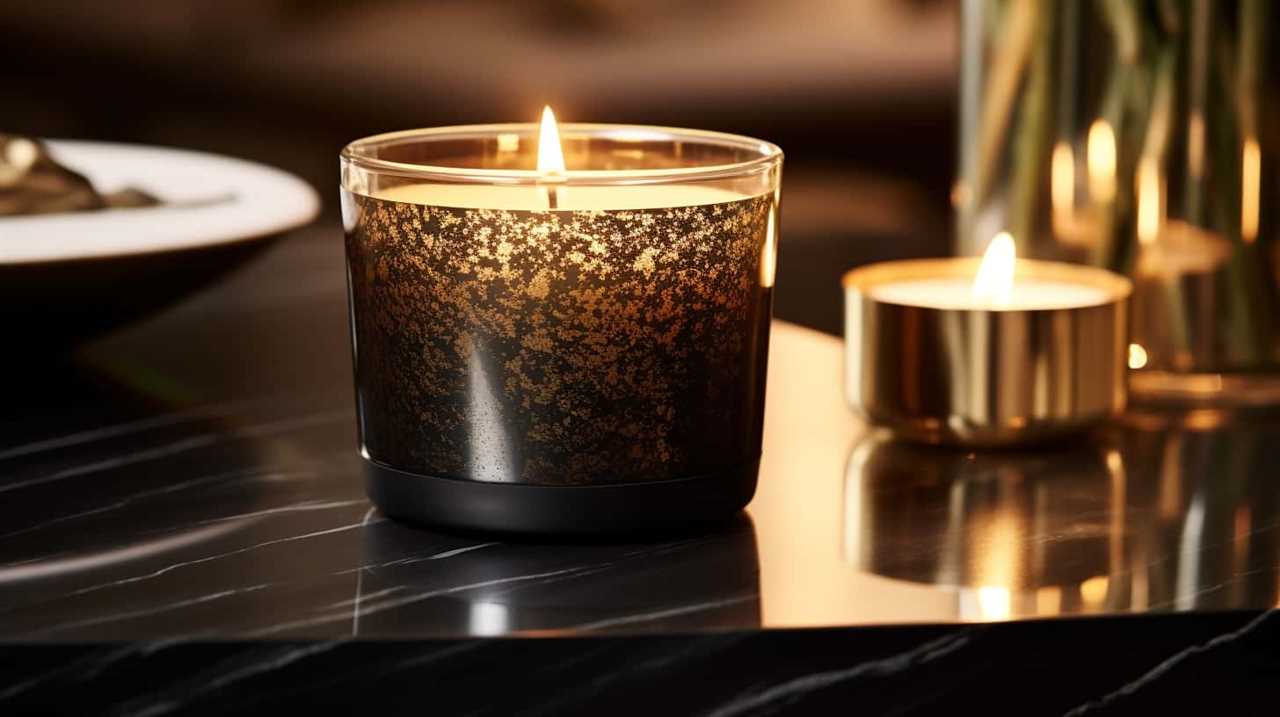
Were you aware that a mere 20% of those who own candles manage to obtain a completely even burn? If you’re aiming for candle perfection, just like we do, you’ve found the ideal spot.
Getting your candle to burn evenly is not only aesthetically pleasing, but it also ensures that you get the most out of your candle’s burn time. In this guide, we will share some expert tips and techniques to help you achieve that elusive, even burn.
From choosing the right candle size to properly trimming the wick, we’ll cover all the essential steps.
So, let’s dive in and learn how to make your candles burn evenly like a pro!

Key Takeaways
- Choose the appropriate candle size based on the space and desired burn time
- Trim the wick before lighting and regularly maintain it to prevent excessive smoke and improve flame control
- Use even burning techniques such as trimming the wick to prevent tunneling and promote optimal wax consumption
- Burn the candle for the recommended amount of time and keep it away from drafts and proper storage to ensure even burning and maintain the quality of the candle.
Choose the Right Candle Size
To ensure an even burn, we should select the appropriate candle size. Candle size selection is crucial for achieving optimal burning conditions.
When choosing the right candle type, consider the size of the space you want to fill with fragrance and ambiance. A larger room may require a larger candle to distribute the scent effectively. Additionally, the burn time of the candle should be taken into account. If you want a longer burning experience, opt for a larger candle size with a longer burn time. On the other hand, if you prefer shorter bursts of fragrance, a smaller candle size might be more suitable.
By choosing the right candle size, you set the foundation for an even burn and a satisfying candle experience.
Now, let’s explore the importance of trimming the wick before lighting.

Trim the Wick Before Lighting
Before lighting your candle, it’s important to trim the wick to ensure an even burn. Trimming the wick helps to prevent excessive smoke, soot, and mushrooming, which can lead to an uneven burn.
Wick Trimming Importance
We always make sure to trim the wick of our candles before lighting them to promote an even burn. Wick maintenance is crucial for preventing uneven burning and ensuring the longevity of your candles.
Here are three reasons why trimming the wick is important:
- Improved flame control: Trimming the wick to the recommended length (about 1/4 inch) helps control the size of the flame. A longer wick can lead to a larger flame, which can cause excessive heat and uneven burning.
- Reduced soot and smoke: A trimmed wick reduces the amount of soot and smoke produced during the burning process. This not only keeps your candles clean but also prevents the release of harmful particles into the air.
- Longer burn time: By regularly trimming the wick, you can extend the burn time of your candles. A properly trimmed wick ensures a steady and controlled burn, maximizing the lifespan of your candle.
Even Burning Techniques
To achieve an even burn when lighting candles, it’s essential that we trim the wick beforehand. Candle maintenance is crucial for preventing tunneling, which is when the wax burns down the center, leaving unused wax on the sides.

By trimming the wick to about a quarter of an inch before each use, we ensure proper burning and prevent excessive smoke and soot. This technique allows the flame to draw the optimal amount of wax, promoting an even burn and maximizing the candle’s lifespan.
Trimming the wick also helps to prevent mushrooming, where the wick forms a bulbous shape at the top, which can cause uneven burning and create black soot. By incorporating regular wick trimming into our candle care routine, we can enjoy a consistently even burn and extend the life of our candles.
Burn the Candle for the Right Amount of Time
Once the candle is lit, it’s crucial to allow it to burn for the appropriate duration. Burning time plays a significant role in achieving an even burn and maximizing the lifespan of your candle. Here are some key points to keep in mind:
- Avoid short burns: Lighting a candle for just a few minutes can cause tunneling, where the wax melts unevenly and creates a hole in the center.
- Follow the manufacturer’s instructions: Different candles have different recommended burn times. Read the label or packaging to ensure you’re burning the candle for the right duration.
- Trim the wick regularly: A trimmed wick ensures a controlled and even burn. Trim it to about ¼ inch before each lighting.
By understanding the importance of burning time and following proper candle care, you can maintain an even burn and extend the life of your candle.
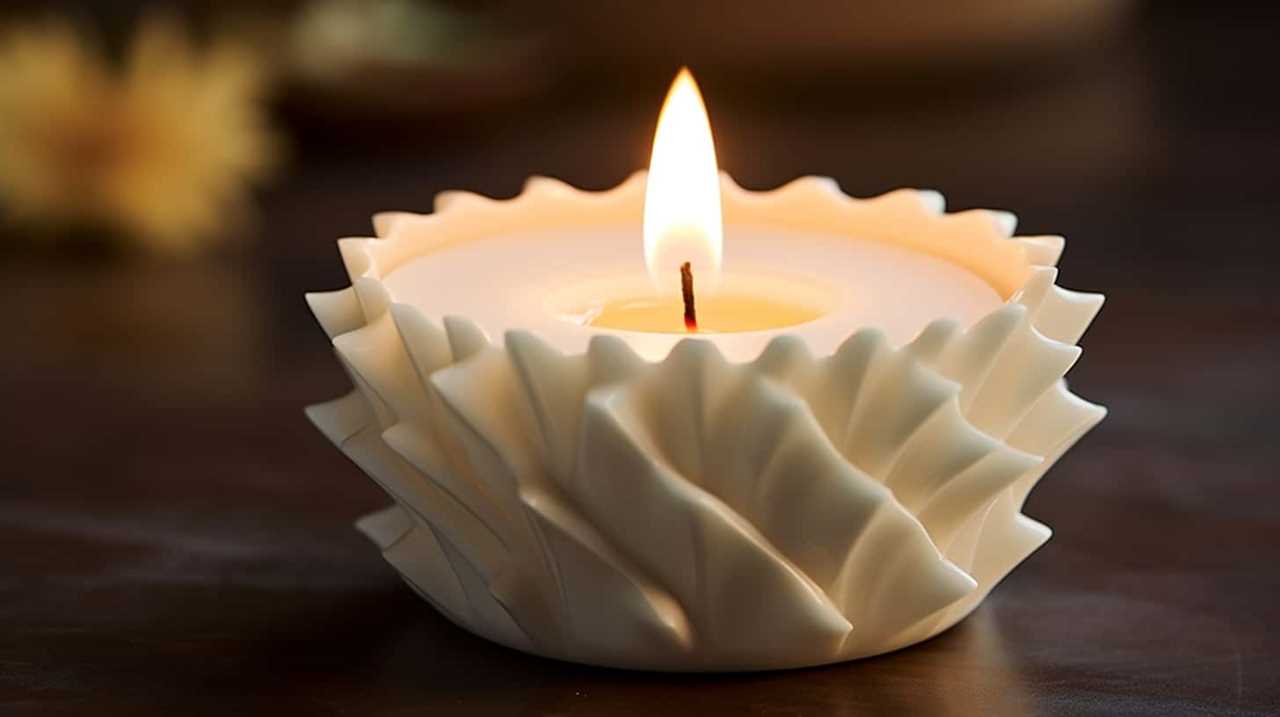
Now, let’s move on to the next essential tip: keeping the candle away from drafts.
Keep the Candle Away From Drafts
To ensure an even burn, it’s crucial to keep your candle away from drafts. Eliminate air currents by closing windows and doors in the room.
Avoid placing the candle in breezy areas, such as near vents or fans, as this can cause the flame to flicker and burn unevenly.
Eliminate Air Currents
We can ensure that our candles burn evenly by keeping them away from drafts and eliminating air currents. Air currents can disrupt the flame and cause the candle to burn unevenly, resulting in uneven melting and tunneling.

To prevent this, we need to take certain precautions:
- Place the candle in a location where there’s minimal air movement, such as away from open windows or vents.
- Avoid placing the candle near fans, air conditioning units, or areas with high foot traffic.
- Use candle holders or containers with lids to provide a barrier against drafts.
By taking these steps, we can eliminate air currents and create a stable environment for our candles to burn evenly and beautifully.
Now, let’s explore how to avoid breezy areas and further enhance our candle burning experience.
Avoid Breezy Areas
Let’s keep our candle away from drafts to ensure it burns evenly. Avoiding breezy areas is crucial in preventing uneven burning and maintaining the overall quality of your candle.

Drafts can cause the flame to flicker and dance, leading to an uneven melt pool and an uneven burn. This can result in wasted wax and an unsightly, uneven surface.
To avoid this, place your candle in a location where it’s protected from drafts, such as near a closed window or away from air vents. Additionally, be mindful of any fans or air conditioning units that may create air currents around the candle.
Rotate the Candle Periodically
Periodically rotating the candle ensures an even burn throughout its lifespan. When a candle is burned consistently in one spot, it can cause uneven melting and tunneling, which reduces its overall burn time. To prevent this, follow these tips:
- Rotate the candle every 2-4 hours of burn time. This will allow the wax to melt evenly and prevent tunneling.
- Use a heat-resistant glove or cloth to protect your hands when handling a hot candle.
- Be gentle when rotating the candle to avoid splashing hot wax.
By rotating the candle regularly, you’re distributing the heat evenly and preventing uneven burning. This will ensure that you get the most out of your candle and enjoy a longer, more even burn.

Use a Candle Snuffer to Extinguish the Flame
To ensure an even burn and minimize the risk of causing uneven melting and tunneling, it is important to use a candle snuffer to extinguish the flame. A candle snuffer is a simple tool specifically designed for safely and effectively putting out candles. It works by depriving the flame of oxygen, causing it to go out without any smoke or wax splatter. Using a candle snuffer has several benefits compared to other methods of extinguishing candles. Firstly, it prevents the wick from smoldering, which can create an unpleasant smell and affect the quality of the next burn. Secondly, it reduces the risk of accidentally blowing hot wax onto surfaces or nearby objects. While there are alternatives to candle snuffers, such as blowing out the flame or using a candle lid, a snuffer remains the best option for achieving a clean and even burn.
| Benefits of Using a Candle Snuffer | Candle Snuffer Alternatives |
|---|---|
| Prevents smoldering of the wick | Blowing out the flame |
| Reduces risk of wax splatter | Using a candle lid |
| Ensures a clean and even burn |
Store Candles Properly When Not in Use
We should always store our candles properly when they aren’t in use to maintain their quality and prevent any potential damage. Proper candle storage is crucial for preserving the integrity of the candle and ensuring a clean burn. Here are three important tips to follow:
- Keep candles in a cool, dry place away from direct sunlight. Exposure to heat and light can cause the wax to soften or discolor.
- Store candles upright to prevent any warping or bending of the wick. This will ensure an even burn and prevent candle tunneling.
- Avoid stacking candles on top of each other as this can lead to scratches or dents. Instead, place them in separate containers or use dividers to keep them separated.
Frequently Asked Questions
Can I Use Any Size of Candle to Achieve an Even Burn?
We can achieve an even burn with different candle sizes. The key is to trim the wick to 1/4 inch, allow the candle to burn for 2-3 hours on the first use, and keep it away from drafts.
How Often Should I Trim the Wick Before Lighting the Candle?
We recommend trimming the wick before each use for an evenly burning candle. This frequent wick trimming ensures optimal burning conditions and prevents uneven flames. Use sharp scissors and trim to about 1/4 inch for best results.

Should I Always Burn the Candle Until the Entire Surface Has Melted?
To ensure optimal burning time and candle safety, it is recommended to always burn the candle until the entire surface has melted. This promotes even burning and prevents tunneling, allowing you to fully enjoy your candle.
Can I Place the Candle Near a Window or an Open Door?
Placing the candle near a window or an open door can disrupt the air flow and cause an uneven burn. To ensure an even burn, it’s best to keep the candle away from drafts.
Is It Necessary to Rotate the Candle if It Is Already Burning Evenly?
Rotating a burning candle is not necessary if it is already burning evenly. However, candle rotation can have benefits like preventing tunneling. Alternative methods, such as trimming the wick and using a candle topper, can also help achieve an even burn.
Conclusion
In the quest for an evenly burning candle, it’s essential to choose the right size, trim the wick, burn for the appropriate time, avoid drafts, rotate periodically, and use a candle snuffer.

By following these expert tips, your candle will radiate a warm and steady glow, creating a soothing ambiance in your space.
Just as a harmonious flame dances gracefully, so too will your candle burn evenly, bringing a sense of balance and tranquility to your surroundings.
I’m Jane and I love candles. I have candles everywhere in my house–in every room, on every surface. I love the smell of candles, and I love how they make my place feel warm and cozy.
Candles are really important to me. They help me relax and de-stress after a long day. They remind me of happy memories, and they make me feel calm and peaceful. I can’t imagine my life without candles!
Candles
How to Fix Wick in Candle

Feeling frustrated with a wick that won’t stay straight in your candle? Worry no more! We’re on hand to assist. This tutorial will demonstrate how to adjust your candle’s wick effortlessly and accurately.
By following our simple steps, you’ll be able to master the art of wick-fixing in no time. So, let’s get started and bring that wick back to its rightful place.
- Retrieve your wick trimmer or scissors.
- Trim the wick to the appropriate length.
- Realign the wick in the center of the candle.
- Secure it with a wick holder or pencil.
- Patiently wait for the wax to harden.
Once your candle is fixed, you can test the wick and enjoy the soothing glow of a perfectly functioning candle.
Key Takeaways
- Observing the wick’s location and centering it in the wax pool is important for proper burning.
- Using clean tools like a wick trimmer or sharp scissors is essential for trimming the wick.
- Trimming the wick to about 1/4 inch length helps maintain a clean and efficient burn.
- Realigning and securing the wick with a wick holder or pencil prevents uneven burning and wasted wax.
Assess the Wick Position
In this step, we’ll assess the position of the wick in the candle. Wick position assessment is crucial for troubleshooting wick issues and ensuring a clean, even burn.

Start by observing the wick’s location in relation to the wax pool. Ideally, the wick should be centered and upright, with a small amount of wick protruding from the wax.
If the wick is off-center or leaning towards one side, gently nudge it back to the center using a wick trimmer or a pair of tweezers.
Additionally, check for any debris or buildup around the wick that could obstruct the flame. If necessary, carefully remove any obstructions.
Once the wick is properly positioned, it’s time to retrieve a wick trimmer or scissors to move on to the next step.

Retrieve a Wick Trimmer or Scissors
Let’s grab a wick trimmer or a pair of scissors to continue fixing the wick in the candle. These tools are essential for trimming the wick to the appropriate length, which is crucial for preventing common wick problems such as excessive smoking, flickering, and uneven burning.
While a wick trimmer is specifically designed for this task, you can also use a pair of sharp scissors as a trimmer alternative. To retrieve a wick trimmer or scissors, make sure they’re clean and free from any debris or wax residue. This will ensure a clean cut and optimal performance.
Now that we have our trimming tool ready, let’s move on to the next step: trimming the wick to the appropriate length.
Trim the Wick to the Appropriate Length
Now that we’ve retrieved a wick trimmer or scissors, it’s time to trim the wick to the appropriate length.

This step is crucial in maintaining a clean and efficient burn for your candle. By ensuring the wick is at the proper length, we can prevent excess smoke, soot, and uneven burning.
Let’s dive into the details of how to achieve the perfect wick length to maximize the enjoyment of your candle.
Proper Wick Length
Trimming the wick to the appropriate length is essential for fixing the wick in a candle. Proper wick length is crucial for optimal wick maintenance and troubleshooting wick issues. Here’s a step-by-step guide to help you trim your wick correctly:
- Start by extinguishing the candle and allowing it to cool completely.
- Remove any debris or burnt wick fragments from the candle.
- Use a wick trimmer or sharp scissors to trim the wick. The ideal length is about 1/4 inch.
- Trim the wick in a straight line to prevent uneven burning.
- Avoid cutting the wick too short as it may cause the flame to extinguish or lead to poor burn performance.
- Dispose of the trimmed wick properly.
- Relight the candle and enjoy its improved performance.
Preventing Candle Smoke
To prevent candle smoke, we need to ensure that the wick is trimmed to the appropriate length. Maintaining the wick is crucial in preventing smoke and ensuring a clean burn. The length of the wick affects how the flame burns, and if it’s too long, it can cause excessive smoke. Here’s a step-by-step guide on how to trim the wick for optimal performance:

| Step | Action |
|---|---|
| 1 | Extinguish the candle and let it cool completely. |
| 2 | Gently remove any debris or charred pieces from the wick. |
| 3 | Measure the recommended length for your specific candle type and diameter. |
| 4 | Use sharp scissors or a wick trimmer to trim the wick to the appropriate length. |
| 5 | Dispose of the trimmed wick pieces properly. |
Realign the Wick in the Center of the Candle
Now let’s address the issue of an off-centered wick in a candle. When the wick isn’t in the center, it can cause uneven burning and a shorter lifespan for the candle.
To realign the wick, there are a few techniques you can try. By gently pushing or nudging the wick towards the center, you can ensure a more even burn and prolong the life of your candle.
Off-Centered Wick Solutions
Let’s realign the off-centered wick in the center of the candle. When the wick is not properly centered, it can lead to uneven burning and wasted wax. There are a few common causes for an off-centered wick, including improper placement during the initial pouring or movement of the candle while it is still hot. To troubleshoot these wick issues, follow these steps:
- Prepare a heat-resistant surface and place the candle on it.
- Light the candle and allow it to burn for a few minutes to create a small pool of melted wax.
- Carefully extinguish the flame and let the wax cool for a minute or two.
- Use a pair of tweezers or a toothpick to gently nudge the wick back to the center of the candle.
By realigning the off-centered wick, you can ensure a more even burn and maximize the lifespan of your candle. Below is a table summarizing the steps:

| Steps |
|---|
| 1. Prepare a heat-resistant surface and place the candle on it. |
| 2. Light the candle and allow it to burn for a few minutes to create a small pool of melted wax. |
| 3. Carefully extinguish the flame and let the wax cool for a minute or two. |
| 4. Use a pair of tweezers or a toothpick to gently nudge the wick back to the center of the candle. |
Wick Realignment Techniques
We can realign the off-centered wick in the center of the candle using specific techniques. Proper wick maintenance is essential to ensure a clean and even burn, and to avoid common wick problems.
Here are four steps to realign the wick:
- Extinguish the candle: Before attempting to realign the wick, make sure the candle is completely extinguished. This will prevent any accidents or injuries.
- Use a wick trimmer: Gently trim the wick to a length of about ¼ inch. This will help the wick burn evenly and prevent excessive smoke.
- Center the wick: Gently push the wick towards the center of the candle using a wick centering tool or a pair of tweezers. Be careful not to apply too much pressure to avoid damaging the wick.
- Trim the wick again: After realigning the wick, trim it once more to ensure it’s at the proper length for optimal burning.
Secure the Wick With a Wick Holder or Pencil
How can we ensure that the wick in a candle is securely held in place? One of the most effective methods is to use a wick holder or a pencil as an alternative. This step is crucial in troubleshooting wick issues and preventing them from detaching or leaning to one side.
Here’s how to securely hold the wick:

- Choose a wick holder or a pencil that’s long enough to reach the bottom of the candle.
- Position the wick holder or pencil in the center of the candle, ensuring that it’s straight and upright.
- Gently wrap the excess wick around the wick holder or pencil, leaving a small amount of slack.
- Adjust the tension of the wick by pulling gently, ensuring it remains centered.
- Press the bottom of the wick holder or pencil into the softened wax at the bottom of the candle to secure it in place.
- Wait for the wax to harden, and then remove the wick holder or pencil, leaving the wick securely held in place.
Wait for the Wax to Harden
After securing the wick with a wick holder or pencil, it’s important to wait for the wax to harden. This step is crucial to prevent wick issues and troubleshoot any problems that may arise during the candle-making process. Here is a step-by-step guide to waiting for the wax to harden:
- Avoid disturbing the candle: Once the wick is secured, refrain from moving or touching the candle. Any movement can disrupt the wax and cause the wick to shift or become misaligned.
- Allow sufficient cooling time: Depending on the type and size of the candle, the wax may take anywhere from a few hours to overnight to completely harden. Patience is key during this process.
- Maintain optimal temperature: Make sure the room temperature is consistent and not too cold or hot. Extreme temperature fluctuations can affect the wax’s ability to harden properly.
- Check for any imperfections: Once the wax has hardened, inspect the candle for any issues such as air bubbles, uneven surfaces, or wick problems. Address these concerns before proceeding to the next steps of the candle-making process.
Test the Wick and Enjoy Your Fixed Candle
To test the wick and enjoy our fixed candle, we can now proceed with the final steps of the candle-making process.
Testing the wick stability is crucial to ensure that our candle burns properly and safely. Light the candle and observe the flame. It should burn steadily, without flickering excessively or producing excessive smoke.
If the flame is too small or extinguishes easily, the wick may be too short or have too much wax coating. Troubleshoot these issues by trimming the wick to a longer length or removing excess wax.

Additionally, if the flame is too large, it may indicate that the wick is too long, causing the candle to burn too quickly. In this case, trim the wick to a shorter length.
Once you have achieved a stable flame, sit back, relax, and enjoy the beautiful glow of your fixed candle.
Frequently Asked Questions
How Do I Know if the Wick Position Is Incorrect in My Candle?
If the wick position is incorrect in a candle, it can lead to issues like a crooked wick or flickering flame. To troubleshoot, check if the wick is centered and trim it if necessary.
Can I Use Regular Scissors Instead of a Wick Trimmer to Trim the Wick?
Yes, you can use regular scissors instead of a wick trimmer to trim the wick. However, it’s important to follow these tips for fixing a misaligned wick to ensure a clean and even burn.

What Is the Appropriate Length to Trim the Wick To?
To achieve the appropriate wick length, it is essential to trim it regularly. Trimming promotes even burning, reduces soot and smoke, and prevents the flame from becoming too large. Follow these steps for mastery.
How Do I Align the Wick in the Center of the Candle?
To fix a tilted wick in a candle and prevent it from leaning to one side, start by gently pushing the wick back to the center using a toothpick or a wick centering tool.
Can I Use Something Other Than a Wick Holder or Pencil to Secure the Wick?
When securing a wick in a candle, we can explore alternatives to a wick holder or pencil. DIY methods include using paperclips, chopsticks, or even clothespins to keep the wick centered and secure.
Conclusion
In conclusion, fixing a wick in a candle is a simple process that can be done with just a few steps.

By assessing the wick position, trimming it to the right length, realigning it in the center, and securing it with a wick holder, you can easily fix your candle.
Don’t worry about the wax hardening as you wait, as it will ensure a longer-lasting burn.
By following these steps, you can enjoy your fixed candle and create a cozy atmosphere in your home.
I’m Jane and I love candles. I have candles everywhere in my house–in every room, on every surface. I love the smell of candles, and I love how they make my place feel warm and cozy.
Candles are really important to me. They help me relax and de-stress after a long day. They remind me of happy memories, and they make me feel calm and peaceful. I can’t imagine my life without candles!
Candles
How to Fix a Candle Wick That Won’t Burn

Ever curious about why your candle wick just won’t light? Don’t worry, we have the answers! This guide will unveil the techniques to mend a defiant candle wick that seems to resist ignition.
Whether you’re a seasoned candle enthusiast or simply looking to master the art of candle care, our step-by-step instructions will help you achieve a perfectly burning wick every time.
From trimming and straightening the wick to priming and re-positioning it, we will teach you the expert techniques to troubleshoot and resolve any wick-related issues.
So, let’s dive in and learn how to effortlessly fix a candle wick that won’t burn.

Key Takeaways
- Proper wick maintenance is essential for troubleshooting wick-related issues.
- Trimming the wick to about ¼ inch before each use helps prevent uneven burn, excessive smoke, and wick drowning in wax.
- Straightening and positioning the wick ensures even heat distribution and a stronger flame.
- Priming the wick enhances the candle’s burning performance, improves wax absorption, and reduces sooting.
Trim the Wick
First, we need to trim the candle wick to ensure an even and consistent burn. Proper wick maintenance is essential for troubleshooting wick-related issues. When a candle’s wick is too long, it can lead to an uneven burn, excessive smoke, and even the wick drowning in melted wax. To avoid these problems, trim the wick to about ¼ inch before each use.
This will help the candle burn evenly and prevent mushrooming, where the wick develops a bulbous shape at the top. To trim the wick, use a pair of scissors or a wick trimmer. Gently cut the excess wick, making sure to remove any charred or burnt parts. By keeping the wick at the correct length, you’ll promote a clean and efficient burn.
Now, let’s move on to the next section and discuss how to use a wick trimmer.
Use a Wick Trimmer
To ensure a properly trimmed wick, we can utilize a wick trimmer. This tool is specifically designed for wick maintenance and can help optimize wick burning techniques. Here are five key benefits of using a wick trimmer:

- Precision: A wick trimmer allows for precise trimming, ensuring the wick is at the ideal length for optimal burning.
- Safety: Trimming the wick with a trimmer reduces the risk of accidents such as excessive smoke or a flickering flame.
- Cleanliness: The trimmer collects the trimmed wick, preventing it from falling into the candle and causing unwanted debris.
- Longevity: Regular wick trimming with a trimmer helps extend the life of your candle by preventing mushrooming and excessive soot.
- Efficiency: A well-trimmed wick promotes even burning and prevents tunneling, ensuring that you get the most out of your candle.
Straighten the Wick
One solution we’ve found effective for fixing a misaligned candle wick is gently adjusting it with a wick straightener. Straightening the wick is crucial for ensuring an even and clean burn.
To straighten the wick, follow these troubleshooting tips. First, ensure that the candle is completely extinguished and cooled before attempting to straighten the wick. Using a wick straightener, gently push the wick back into the desired position, making sure it’s centered and upright. Be careful not to apply too much pressure, as this can cause the wick to break or become misaligned again.
Once the wick is straightened, trim it to the recommended length, typically around 1/4 inch, to optimize the burn. Straightening the wick will help improve the candle’s performance and prevent any potential issues during burning.
Prime the Wick
Now let’s talk about the importance of priming the wick.

Priming the wick before lighting it can enhance the candle’s burning performance. It helps the wax melt evenly and provides a steady flame.
Wick Priming Benefits
We highly recommend priming the wick before lighting it to maximize the benefits of a properly burning candle. Wick priming techniques are essential to ensure a consistent and clean burn throughout the candle’s lifespan.
Here are five benefits of wick priming:
- Improved wax absorption: Priming the wick allows it to absorb the melted wax more efficiently, ensuring a steady fuel supply for the flame.
- Reduced sooting: A properly primed wick produces minimal soot, preventing black smoke and residue buildup.
- Enhanced fragrance throw: By priming the wick, you create optimal conditions for the fragrance oils to evaporate, resulting in a stronger and longer-lasting scent.
- Longer burn time: Primed wicks burn more evenly and slowly, extending the candle’s overall burn time.
- Minimized mushrooming: Primed wicks experience less mushrooming, where carbon deposits form at the tip, reducing the need for frequent trimming.
Wick Priming Techniques?
After understanding the benefits of wick priming, let’s now delve into the various techniques to effectively prime the wick and ensure a successful burn. Wick priming is an essential step in troubleshooting wick issues and can greatly improve the performance of your candles. Here are some tried and tested wick priming techniques:

| Technique | Description |
|---|---|
| Dip and Roll | Dip the wick in melted wax, then roll it between your fingers to remove excess wax and straighten. |
| Brushing | Use a small brush to coat the wick with melted wax, ensuring all parts are evenly covered. |
| Pre-burning | Light the wick and let it burn for a few seconds, then extinguish. Trim any charred ends. |
Remove Excess Wax
To remove excess wax from a candle wick that won’t burn, gently scrape it off using a butter knife or a similar tool. Here are some steps to effectively remove excess wax and maintain your wick:
- Carefully slide the butter knife under the excess wax buildup.
- Apply gentle pressure to lift the wax off the wick.
- Be cautious not to damage the wick while scraping off the wax.
- If the wax is stubborn, try using a hairdryer to soften it before scraping.
- Clean the wick with a soft cloth to remove any remaining residue.
By removing excess wax, you ensure a clean and unobstructed wick, allowing for proper combustion.
Now that we’ve removed the excess wax, let’s proceed to the next step and re-position the wick for optimal burning.
Re-position the Wick
To re-position the wick, carefully hold the base of the wick with a pair of tweezers and gently guide it to a more central position within the candle.

This technique is essential when troubleshooting a candle wick that won’t burn properly. Sometimes, the wick may shift or lean towards one side, causing an uneven burn or a weak flame.
By re-positioning the wick, you can ensure a more even distribution of heat and a stronger flame. It’s important to be gentle and precise when using tweezers to avoid damaging the wick or the surrounding wax. Take your time and make small adjustments until the wick is centered.
This simple re-positioning technique is one of the effective troubleshooting tips to fix a candle wick that won’t burn.
Use a Wick Sustainer
Now let’s talk about the benefits of using a wick sustainer and the alternatives available.

A wick sustainer is a small metal device that helps keep the wick centered and upright, ensuring a consistent burn. It prevents the wick from leaning to one side or falling into the wax, which can cause the candle to burn unevenly or not burn at all.
If you don’t have a wick sustainer, there are other DIY alternatives you can try to achieve a similar effect.
Wick Sustainer Benefits
Using a wick sustainer ensures that the candle wick remains in the optimal position for a consistent and efficient burn. Here are five benefits of using a wick sustainer:
- Improved Burn Stability: A wick sustainer keeps the wick centered and straight, preventing it from leaning or drowning in the wax, resulting in a more stable and even burn.
- Reduced Smoking and Sooting: By keeping the wick properly positioned, a wick sustainer helps minimize smoking and sooting, leading to a cleaner and healthier burning experience.
- Extended Candle Lifespan: With a wick sustainer, the candle burns evenly, allowing it to last longer and maximizing its lifespan.
- Enhanced Safety: By preventing the wick from becoming too long or falling into the wax, a wick sustainer reduces the risk of accidental fires and ensures a safer burning environment.
- Easy Maintenance: Wick sustainers make it easy to trim the wick and replace it when needed, simplifying candle maintenance and prolonging its usability.
Transitioning into the subsequent section about ‘wick sustainer alternatives,’ let’s explore some other options that can be used in place of a wick sustainer.

Wick Sustainer Alternatives
Let’s explore some other options for wick sustainer alternatives that we can use instead. When troubleshooting wick problems, it’s important to consider different solutions. Here are a few alternatives to using a traditional wick sustainer:
| Alternative | Description |
|---|---|
| Paperclip | A simple and easily accessible option. Unfold a paperclip and shape it into a small loop to hold the wick in place. |
| Bobby Pin | Another readily available option. Use a bobby pin to secure the wick by opening it up and sliding the wick through the looped end. |
| Safety Pin | Similar to the bobby pin method, a safety pin can be used to secure the wick. Make sure the pin is closed tightly to prevent any accidents. |
These alternatives can be useful when you don’t have a wick sustainer on hand or if you want to try something different. Remember to always monitor your candle while it burns to ensure safety and proper functioning.
Frequently Asked Questions
How Do I Prevent My Candle Wick From Tunneling?
To prevent tunneling in candle wicks, we troubleshoot common problems like wicks that won’t stay lit. By trimming the wick before each use, providing proper air circulation, and using quality candles, we can fix this issue.
Can I Use a Regular Pair of Scissors Instead of a Wick Trimmer to Trim the Wick?
Using regular scissors instead of a wick trimmer may seem convenient, but it can negatively affect the burn of your candle. Wick trimmers are designed to create a precise angle that promotes an even and clean burn, preventing tunneling and prolonging the candle’s lifespan.
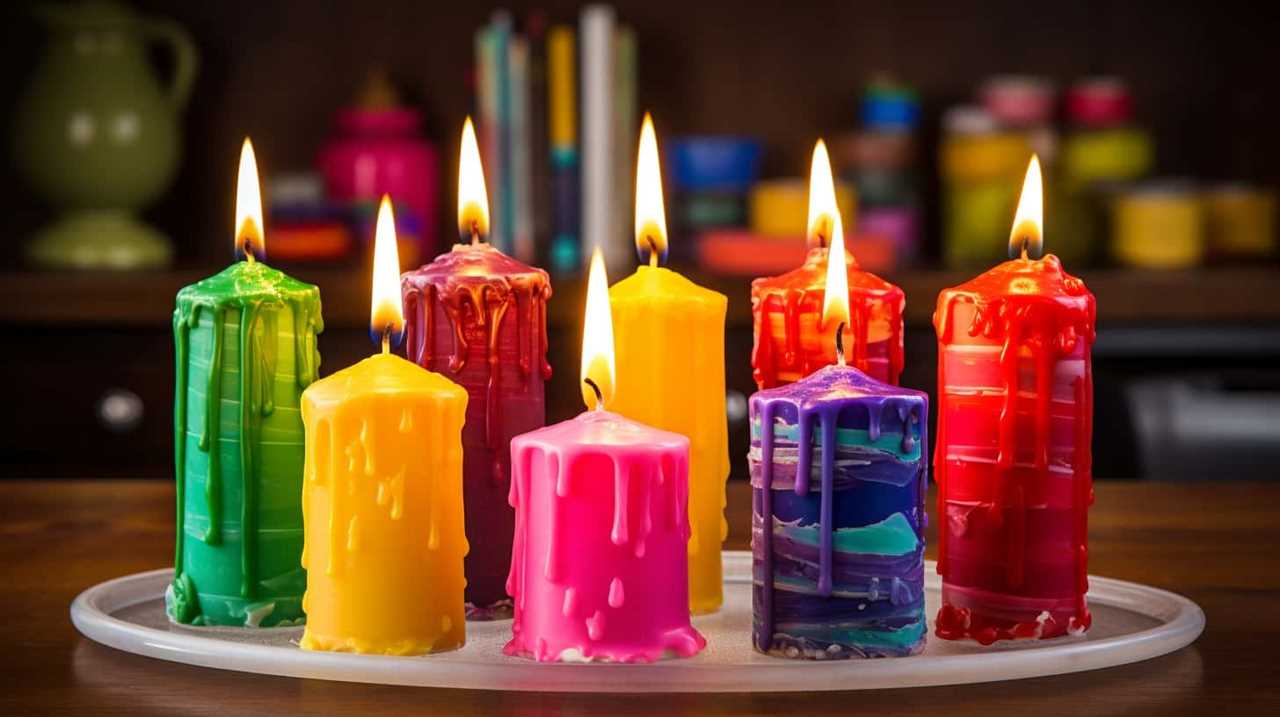
Is It Necessary to Prime the Wick Every Time I Light the Candle?
Yes, it is necessary to prime the wick every time you light the candle. Using a different type of wick may affect the burn. Common reasons for a wick not burning include buildup, moisture, or an incorrect wick size.
What Should I Do if My Candle Wick Is Too Short to Light?
If your candle wick is too short, gently push it up using a toothpick or a wick trimmer. Be careful not to damage the wax or disturb the surrounding area.
Are There Any Alternative Methods to Fix a Candle Wick That Won’t Burn?
Alternative methods and troubleshooting tips can be used to fix a candle wick that won’t burn. Understanding the cause, such as excess wax or a clogged wick, is crucial. Techniques like trimming, relighting, or using a lighter can help resolve the issue.
Conclusion
In conclusion, by following these simple steps, you can easily fix a stubborn candle wick that refuses to burn.

- Trim and straighten the wick
- Prime the wick
- Remove any excess wax for optimal burning
If needed, re-position the wick or use a wick sustainer.
Remember, with these techniques at your disposal, you’ll never have to suffer from a non-burning candle again. Say goodbye to wick troubles and enjoy the soothing ambiance of a perfectly burning candle.
I’m Jane and I love candles. I have candles everywhere in my house–in every room, on every surface. I love the smell of candles, and I love how they make my place feel warm and cozy.
Candles are really important to me. They help me relax and de-stress after a long day. They remind me of happy memories, and they make me feel calm and peaceful. I can’t imagine my life without candles!
Candles
How to Get a Candle Out of a Mold

Are you eager to discover how to easily release your candles from their molds without any hassle? Search no more!
In this guide, we, the candle enthusiasts, will share with you the art of liberating your creations with finesse and precision. No more struggling or frustration – we’ve got you covered.
Discover the mastery of getting a candle out of a mold, using tried and true techniques that will have you feeling like a candle-making maestro. From preparing your mold to the final twist and turn, we’ll guide you step by step, ensuring a smooth and successful extraction every time.
So, let’s dive in and unveil the mystery of mold removal, empowering you to create stunning candles with ease.
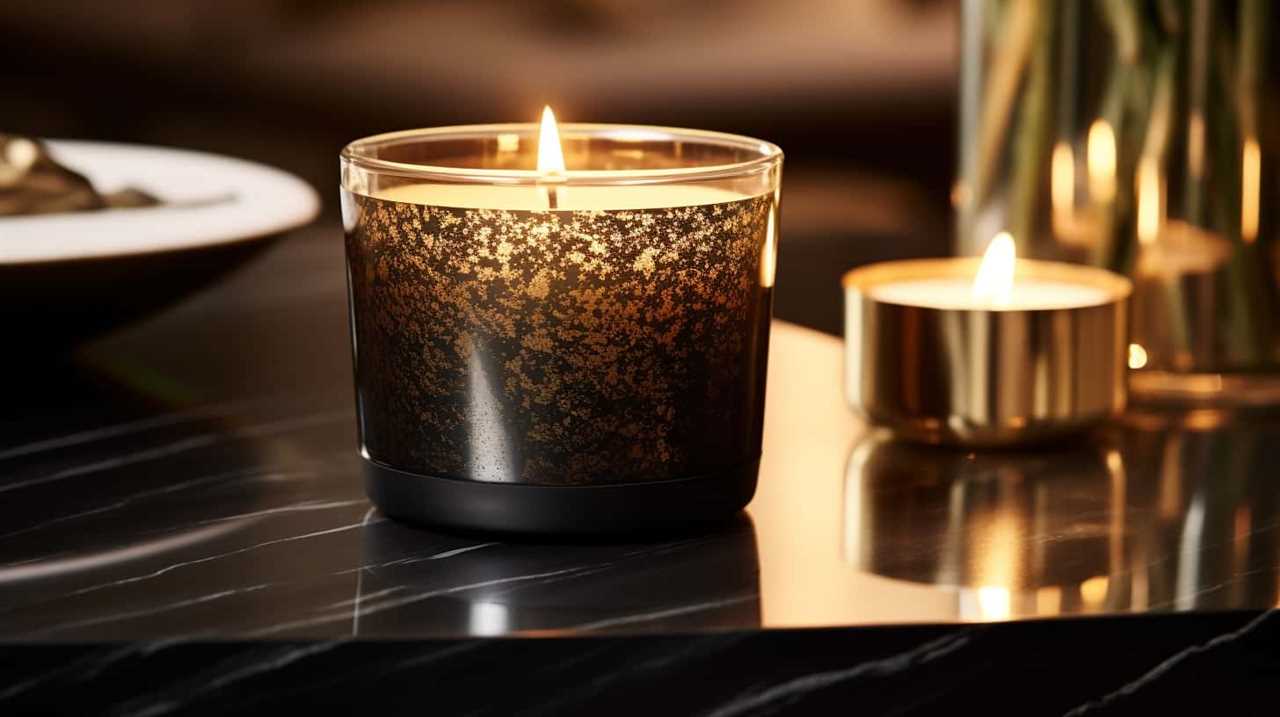
Key Takeaways
- Applying a release agent such as cooking spray, vegetable oil, or silicone spray is important to prevent sticking.
- Chilling the mold helps solidify the wax and prevent sticking or breaking.
- Gentle tapping, applying pressure, and coaxing the candle out with nimble hands can help remove it from the mold.
- Alternative methods such as tapping with a rubber mallet, using hot water, freezing, or using a hairdryer can also aid in candle removal.
Prepare Your Mold
To prepare our mold for removing the candle, we’ll start by applying a release agent. This is a crucial step that will prevent the candle from sticking to the mold, making it easier to remove later on. There are various release agents available in the market, but if you prefer alternative mold materials, you can use alternatives like cooking spray or vegetable oil.
Simply spray or brush the release agent onto the inside of the mold, ensuring that all surfaces are covered.
Next, check for any potential mold issues such as cracks or uneven surfaces. These can affect the quality of the final candle and make it difficult to release from the mold. If you encounter any issues, troubleshoot them by repairing the mold or using a different mold altogether.
Use a Release Agent
Now let’s talk about using a release agent when getting a candle out of a mold.
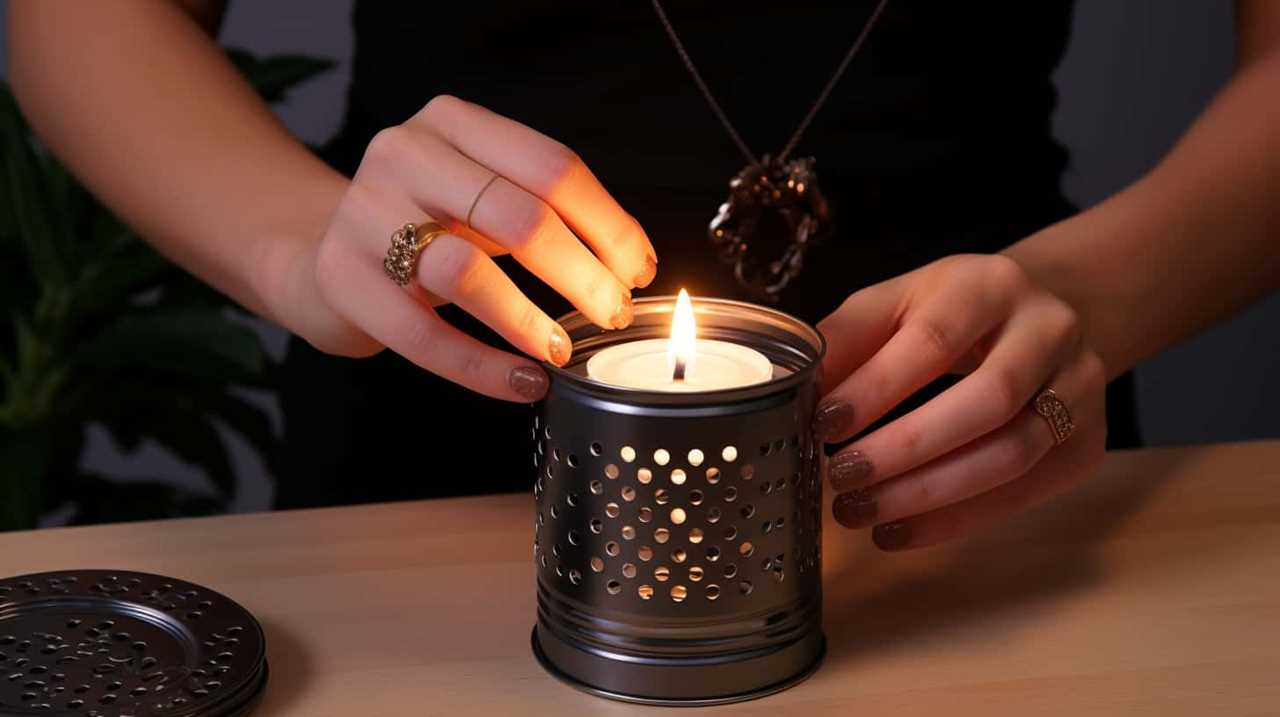
One alternative release agent is cooking spray, which can be sprayed directly onto the mold. This lubricates the surface and makes it easier for the candle to slide out smoothly.
Using a release agent is important as it prevents the candle from sticking to the mold and potentially breaking during the removal process.
Alternative Release Agent
We can achieve an easier release of the candle from the mold by applying an alternative release agent.
While using a traditional release agent like cooking spray or vegetable oil is effective, there are alternative options available that can yield even better results.

One alternative release agent is silicone spray, which can be applied to the mold before pouring the wax. Silicone spray provides a smooth and slippery surface, allowing the candle to easily slide out of the mold once it has cooled and hardened.
Another alternative option is using a mixture of rubbing alcohol and water as a release agent. This solution helps to remove any residue left behind by the candle wax, ensuring a clean and easy release.
Importance of Lubrication
After applying an alternative release agent, such as silicone spray or a mixture of rubbing alcohol and water, we can now discuss the importance of lubrication in easily removing a candle from its mold. Lubrication techniques and the benefits of using a release agent are crucial to ensure a smooth and effortless candle removal process. Here are five key points to consider:
- Prevents sticking: A release agent creates a barrier between the candle and the mold, preventing the wax from sticking and making it easier to remove.
- Preserves mold integrity: By using a release agent, you reduce the risk of damaging the mold during the removal process.
- Saves time: Lubrication techniques help the candle slide out smoothly, saving you time and effort in removing each candle from the mold.
- Ensures a clean finish: A release agent helps in achieving a clean and polished appearance for your candles, without any unsightly marks or imperfections.
- Increases mold lifespan: Regular use of a release agent prolongs the life of your molds, allowing you to create multiple candles without the need for frequent replacements.
Preventing Sticking and Breaking
To prevent sticking and breaking during the candle removal process, we need to utilize a release agent. This is a crucial step in ensuring that the candle comes out smoothly and without any damage.

A release agent is a substance that’s applied to the mold before pouring the wax. It creates a barrier between the wax and the mold, preventing sticking and avoiding cracks. There are various types of release agents available, such as silicone sprays, vegetable oils, or even non-stick cooking sprays.
When applying the release agent, make sure to cover every nook and cranny of the mold to ensure a thorough coating. Once the release agent is applied, it’s time to move on to the next step: chilling the mold.
Chill the Mold
The effectiveness of chilling the mold is enhanced by the use of refrigeration. Chilling the mold before attempting to remove the candle helps solidify the wax, making it easier to release from the mold without breaking or sticking. Here are some chilling techniques and the benefits of chilling:
- Refrigeration: Placing the mold in the refrigerator for a few hours helps cool down the wax, making it less likely to stick to the mold walls.
- Freezer Method: For a quicker chill, the mold can be placed in the freezer for about 30 minutes. This rapid cooling reduces the chances of the candle sticking.
- Ice Bath: Another option is to submerge the mold in an ice bath. The cold water helps chill the mold evenly, promoting easy release.
- Chilling Spray: Using a chilling spray specifically designed for candle making can provide a quick and effective way to cool the mold and prevent sticking.
- Chilling Plate: Placing the mold on a chilled plate or surface can help cool the wax uniformly, ensuring an even release.
Chilling the mold before attempting to remove the candle offers several benefits, such as minimizing the risk of breaking the wax and ensuring a smooth release. By following these chilling techniques, you can achieve mastery in getting a candle out of a mold.

Apply Gentle Pressure
We gently apply pressure to the mold to release the candle without causing any damage or sticking. After chilling the mold and allowing it to sit for a few minutes, we’re ready to proceed with the next step.
First, we inspect the edges of the mold to ensure there are no obstructions or excess wax buildup. Then, we begin by gently tapping around the sides of the mold with our fingertips. This helps to loosen the candle and create small gaps between the wax and the mold.
If the candle still doesn’t budge, we can try the warm water method. By submerging the bottom of the mold in warm water for a few seconds, the heat will cause the wax to expand slightly, making it easier to release the candle.
With a gentle twist and a slight push, the candle should slide out smoothly from the mold.

Tap the Mold
Now that we’ve applied gentle pressure to the mold, the next step is to tap it.
Tapping the mold helps to loosen the candle and encourage it to release from the sides.
To tap the mold, firmly but gently tap all around the outside of the mold with the palm of your hand or a soft mallet.
This technique can be especially effective for stubborn candles that aren’t easily coming out with just pressure alone.

Candle Release Techniques
To release the candle from the mold, gently tap the sides of the mold using a soft object. This candle release technique is effective in loosening the candle and allowing it to easily slide out of the mold.
Here are some candle release tips and troubleshooting mold removal techniques to help you in this process:
- Use a rubber mallet or a wooden spoon to tap the sides of the mold.
- Start tapping at the top of the mold and work your way down to the bottom.
- Apply light to medium pressure while tapping to avoid damaging the mold or the candle.
- Rotate the mold as you tap to ensure even pressure distribution.
- If the candle doesn’t release, try placing the mold in the freezer for a few minutes to shrink the wax and make it easier to release.
Alternative Mold Removal Methods
An effective method to remove a candle from a mold is by gently tapping the sides of the mold with a soft object. This technique is one of the alternative mold release techniques that can be used when dealing with stubborn or stuck candles.
When a candle gets stuck in the mold, it can be frustrating, but tapping the mold can help loosen it and make it easier to remove. To tap the mold, take a soft object like a rubber mallet or a wooden spoon and gently tap the sides of the mold all around. The vibrations created by tapping can help to loosen the candle and release it from the mold.

If tapping alone doesn’t work, don’t worry, there are other methods you can try, such as using hot water.
Use Hot Water
We can easily remove a candle from a mold by using hot water. This method is effective and prevents candle deformation, especially if the candle has been stuck in the mold for too long. Here is a step-by-step guide on how to use hot water to remove a candle from a mold:
- Fill a large bowl or sink with hot water, making sure it’s not boiling.
- Place the mold in the hot water, ensuring that the water level is high enough to cover the sides of the mold.
- Let the mold sit in the hot water for a few minutes to allow the heat to soften the wax.
- Gently twist and turn the mold to loosen the candle.
- Carefully pull the candle out of the mold, ensuring not to damage it.
By using hot water, you can successfully remove a candle from the mold without any deformation.
Now, let’s move on to the next method: freezing the candle.

Freeze the Candle
We can freeze the candle to make it easier to remove from the mold. Freezing the candle helps to shrink it slightly, allowing it to contract away from the sides of the mold. This makes it less likely to stick and prevents any damage to the candle during removal.
To freeze the candle, place the mold in the freezer for at least 30 minutes or until the candle feels firm. It’s important to ensure that the candle is completely solid before attempting to remove it from the mold.
Once frozen, gently tap the mold on a hard surface to loosen the candle. If it still doesn’t come out easily, you can try running warm water over the outside of the mold to further melt any remaining wax.
These preventive measures and troubleshooting tips will help you successfully remove a candle from the mold using the freezing method.

Twist and Rotate the Mold
Now that the candle is frozen and ready to be removed from the mold, it’s important to twist and rotate the mold to loosen the candle. This technique helps to release any suction or adhesion between the candle and the mold, making it easier to slide the candle out.
Mold Removal Techniques
To successfully remove a candle from a mold, it’s important to employ the technique of twisting and rotating the mold. This method helps loosen the candle and allows for easy extraction.
Here are some mold removal techniques to help you with this process:
- Inspect the mold: Before attempting to remove the candle, inspect the mold for any signs of stubborn mold. If you notice any, you may need to clean it using appropriate mold cleaning techniques before proceeding.
- Apply gentle pressure: Hold the mold firmly and apply gentle pressure while twisting and rotating it. This will help break the seal between the candle and the mold.
- Use a lubricant: If the candle is still stuck, try using a small amount of lubricant, such as vegetable oil or cooking spray, to make it easier to remove.
- Tap the mold: Lightly tap the mold on a flat surface to further loosen the candle.
- Slowly extract the candle: Once the candle is loosened, slowly and carefully extract it from the mold by continuing to twist and rotate.
Preventing Candle Breakage
Continuing with inspecting the mold for any signs of stubborn mold, we can now focus on preventing candle breakage by employing the technique of twisting and rotating the mold. This simple yet effective method ensures that the candle releases from the mold smoothly and without any damage. By gently twisting and rotating the mold, you create movement that prevents the wax from sticking to the sides. This technique is especially crucial when using silicone or rubber molds, as they tend to hold on to the candle more tightly.
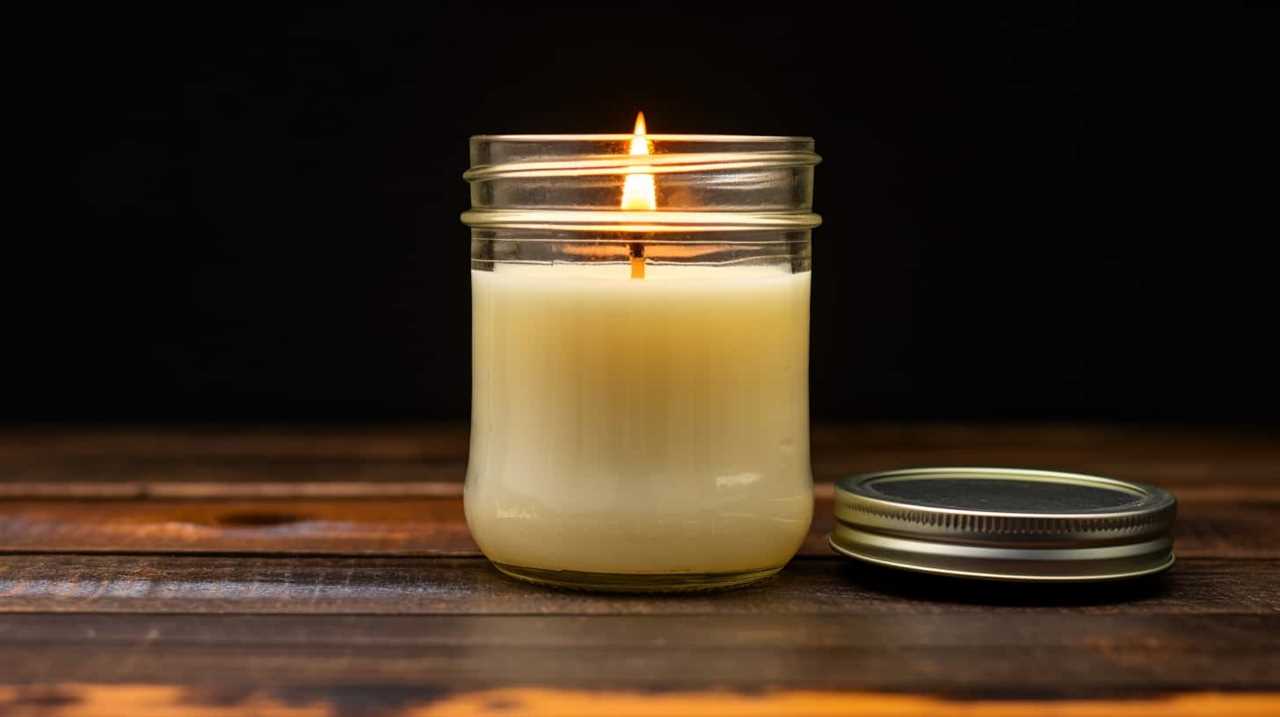
To further prevent mold buildup and increase the chances of a successful release, it is important to choose the right mold size for your candle. A mold that is too small can cause the wax to expand and crack the mold, while a mold that is too large can lead to an uneven burn and a weaker candle. Refer to the table below to find the appropriate mold size for your candle:
| Candle Diameter (inches) | Mold Diameter (inches) |
|---|---|
| 2 | 2.5 |
| 3 | 3.5 |
| 4 | 4.5 |
| 5 | 5.5 |
| 6 | 6.5 |
Use a Hairdryer
We can easily remove a candle from a mold by utilizing a hairdryer. This hairdryer technique is especially useful when dealing with stubborn or stuck candles. Here’s how to do it:
- Start by plugging in the hairdryer and setting it to the highest heat setting.
- Hold the hairdryer about 6-8 inches away from the mold and direct the hot air towards the base of the candle.
- Move the hairdryer in a circular motion, evenly heating the entire circumference of the mold.
After a few minutes, gently twist and wiggle the candle to see if it starts to loosen. If the candle is still stuck, continue applying heat with the hairdryer and repeat the twisting and wiggling until the candle comes out.
Using this hairdryer technique, you’ll be able to effortlessly remove even the most stubborn candles from their molds. Mastery of this method will ensure a smooth candle-making process every time.

Utilize a Candle Release Spray
To efficiently remove a candle from a mold, we can make use of a candle release spray. This spray acts as a lubricant and creates a barrier between the candle and the mold, making it easier to slide the candle out. Candle release sprays are designed specifically for candle making and are available in craft stores or online.
However, if you don’t have a candle release spray on hand, there are alternative options you can try. For example, you can use cooking oil or non-stick cooking spray as a substitute. When using a candle release spray or alternative, it’s important to consider the type of mold material you’re working with. Common candle mold materials include silicone, metal, and plastic.
Ensure that the spray or alternative you choose is compatible with the material to avoid any damage or sticking.
Frequently Asked Questions
How Long Does It Take for a Candle to Fully Harden in a Mold?
When getting a candle out of a mold, it’s important to consider the hardening time. Depending on the type of wax used, candles can take anywhere from a few hours to a few days to fully harden.
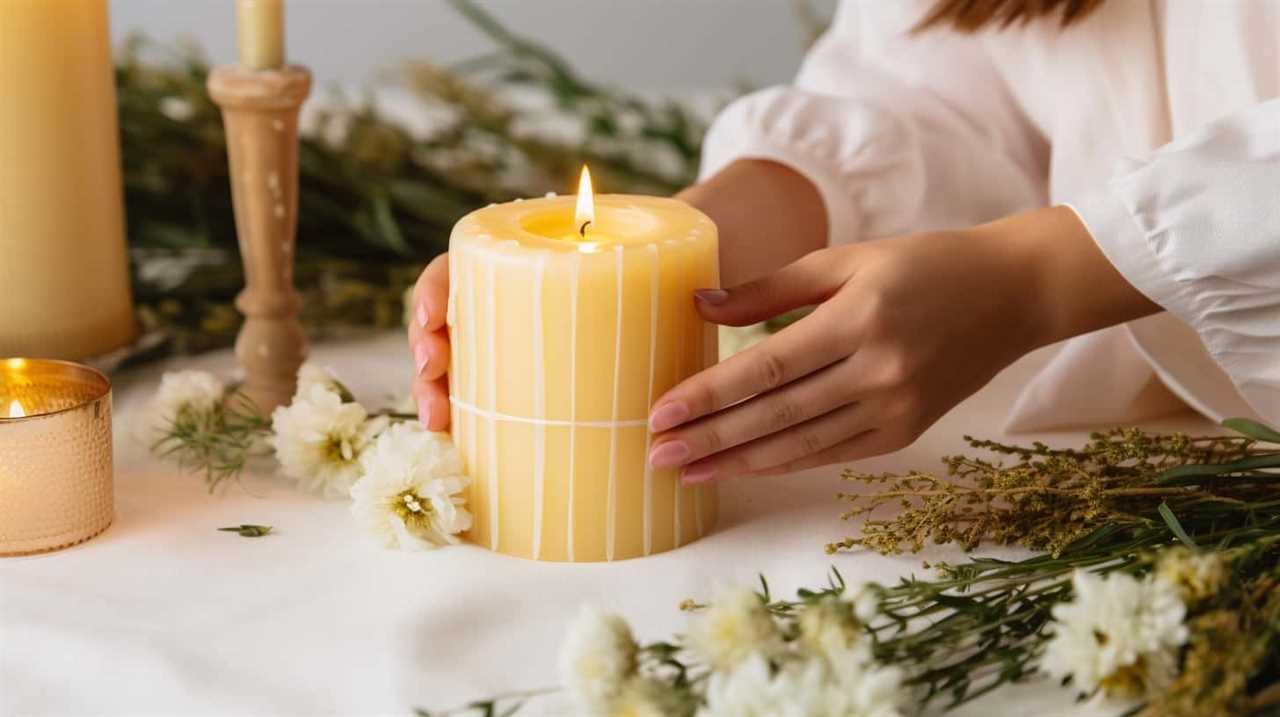
Can I Use Any Type of Mold to Make a Candle, or Are There Specific Requirements?
Can any mold be used for candle making? Well, let us enlighten you. When it comes to candle mold types, there are specific requirements. Suitable materials like silicone, metal, and plastic ensure successful candle making endeavors.
Do I Need to Use a Release Agent Every Time I Make a Candle in a Mold?
We always use a release agent when making candles in molds to ensure easy removal. However, there are alternative methods such as using vegetable oil or non-stick cooking spray. Additionally, we have found that freezing the mold can help remove stubborn candles.
What Is the Best Type of Wax to Use for Candle Making in a Mold?
The best wax types for candle making in a mold depend on various factors. Natural waxes like soy and beeswax offer a clean burn, while synthetic waxes like paraffin provide a longer burn time. Beginners may find soy wax easier to work with due to its lower melting point.
Can I Add Color or Fragrance to the Wax Before Pouring It Into the Mold?
Yes, we can add color and fragrance to the wax before pouring it into the mold. The pros are that it enhances the aesthetic appeal and scent of the candle. However, it requires careful measurement and testing to achieve the desired results.

Conclusion
In conclusion, removing a candle from a mold is a simple process that requires careful preparation and the right techniques. By following the steps outlined in this article, you can easily release your candle from the mold without any hassle.
Remember the adage ‘Patience is a virtue’ and take your time to ensure a successful outcome. With a little patience and practice, you’ll be able to create beautiful candles that are ready to light up any room.
I’m Jane and I love candles. I have candles everywhere in my house–in every room, on every surface. I love the smell of candles, and I love how they make my place feel warm and cozy.
Candles are really important to me. They help me relax and de-stress after a long day. They remind me of happy memories, and they make me feel calm and peaceful. I can’t imagine my life without candles!
-
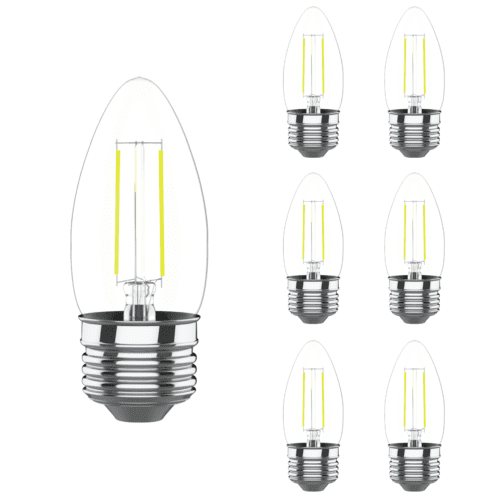
 Beginners Guides2 weeks ago
Beginners Guides2 weeks agoThe Similarities of Candle and Light Bulb Lamps
-

 Beginners Guides3 months ago
Beginners Guides3 months agoHow To Burn A Candle Without A Wick
-

 Beginners Guides2 weeks ago
Beginners Guides2 weeks agoHow to Determine If Candles Will Melt Outside
-

 Beginners Guides4 weeks ago
Beginners Guides4 weeks agoAre Yankee Candles Vegan?
-

 Beginners Guides2 weeks ago
Beginners Guides2 weeks agoWhy is My Candle Not Sticking to the Glass?
-

 Candles4 weeks ago
Candles4 weeks agoHow to Make Scented Candles
-

 Beginners Guides4 weeks ago
Beginners Guides4 weeks agoHow to Make Soy Candles
-

 Beginners Guides3 months ago
Beginners Guides3 months agoHow To Calibrate A Candy Thermometer















